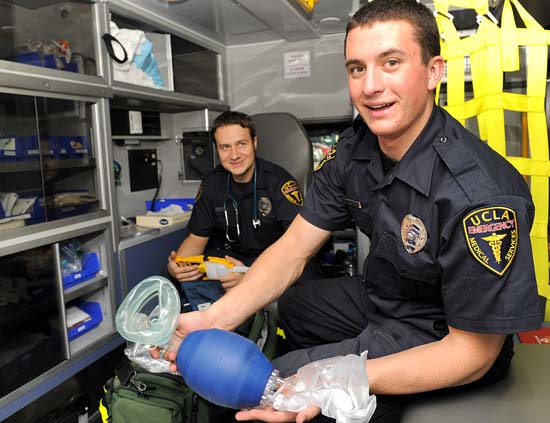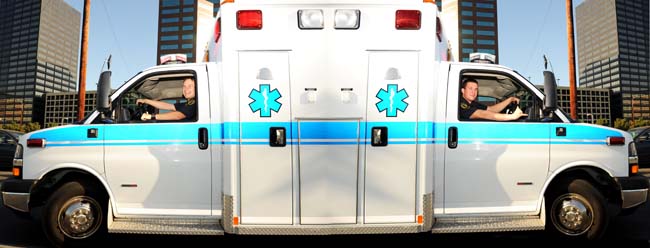
The first call John Thompson ran was a response to a man who had a seizure and cracked his head on a cement planter.
“You have simulations, but here it is in the real life, someone’s bleeding, and … I’m trying to figure out what I’m supposed to do first, what’s more important,” said Thompson, now an emergency medical technician training supervisor.
“It’s just crazy because all these things that are abnormal, that don’t really happen in the simulations, were happening and it’s very nerve-racking,” he added.
Two and a half years later, serving as an EMT for UCLA Emergency Medical Services has only strengthened his resolve to become a doctor, he said.
“I love helping people,” Thompson said. “There’s also an adrenaline rush. When (the radio goes off) you have no idea what’s going to happen next. The dispatcher tells you … (what the problem is), but they’re wrong half the time, so still, you have no idea what’s going to happen when you get there. You have to be able to handle any situation.”
Thompson, who graduated last year and is currently applying to medical school, said all of his life experiences are pointing him toward being a doctor. He said his initial motivation to become an EMT came when he was in high school, when his friend was hit by a car.
“It was really frustrating to see him hurt and not be able help him, so I took an EMT class because I never wanted to be in that situation again,” he said.
The 21 students employed by UCLA Emergency Medical Services are trained in basic life-support and work without paramedics, Thompson said. UCLA EMTs go through about six months of training, which is longer than most companies, and are first on the scene 90 percent of the time, said Dominic Woodson, a probationary EMT.
Taryn Hoffman, EMT hiring coordinator, said EMTs can get to any location on campus within three minutes.
After Thursday’s stabbing incident, EMTs arrived at the scene three minutes after they received the 911 call, police said.
In cases where advanced life support is needed, students work with the Los Angeles City Fire Department paramedics and accompany them to the hospital. UCLA EMS covers the campus and Westwood, responding to about 1400 calls a year, Woodson said.
“You go from being a typical college student, generally, to handling life-and-death situations,” Thompson said. “You have to be able to make mature decisions.”
Along with medical duties, EMTs man the desk at the police station, handle police reports when they contain no suspect information, perform maintenance duties and take care of the lost and found. However, once technicians hear a loud beep signifying a 911 call, they leave the front desk and respond to the emergency.
“Being first on scene is a big responsibility because you have to figure out what’s going on … and to do that requires extra training,” Woodson said.
Training also entails frequent quizzes, simulations, tests on campus geography and shifts of shadowing another EMT, in addition to learning basic medical skills and the EMT handbook.
“Not only are you studying for classes, but you’re studying for the job, too,” Woodson said.
He added that once training ends, the hours are less intense, but it’s still a challenge balancing work, school and having a social life, with the irregular shifts from 7 a.m. to 3 p.m. and 3 p.m. to 7 a.m.
“You might think you’ll come into work and you’ll be able to study but then you’ll get a call, and you’ll keep getting calls and the next thing you know your shift’s over and you never had time to study for your class or your quiz,” the second-year psychobiology student added.
More than 90 percent of students who work as EMTs go to medical school, according to the UCLA EMS Web site.
Thompson, who oversees training, said, “It’s rewarding to see someone going from this scared EMT who has no idea what they’re doing and is sweating profusely when they get their first call and they can’t even speak, to being able to go to a serious incident like a year later and being able to handle it like it was nothing.”
EMTs have a very stressful job, but talking to their partners and other EMTs around helps them deal with the pressure and brings them closer together, Woodson said.
“The biggest thing to remember is that you didn’t put the person in that situation,” he said. “You don’t want to get emotionally attached even though it’s hard because they’re a human being, and you’re a human being, but they’re going to be in a state where it could be very critical.”
He added that EMTs get calls that range from something as small as a stubbed toe, to someone who has gone into full cardiac arrest.
“You could see some nasty, nasty things and you just have to keep going,” he added.
UCLA EMS has one ambulance on call 24 hours a day, 365 days a year, though for certain events, like Undie Run or Bruin Bash, Woodson said, they station a second one.
In the event that two calls come in simultaneously, the EMTs going to the initial incident call in a second ambulance from the LAFD. Regardless of how severe the initial call is, they have to take care of the first one before moving on to the next, he said.
Woodson had previous experience working as an EMT at a local theme park near his home, and said the main difference between the two is having an ambulance available.
“You’re nervous because you’re driving an ambulance, for one thing, and that’s something that I hadn’t done before. You’re driving with lights and sirens and it’s scary because cars might not stop. … You have to be careful all the time,” Woodson said.
Despite the challenges that come with being an EMT, Woodson said he wants to pursue a medical career even more.
“The most rewarding experience is just knowing you helped someone,” he said. “If someone’s really critical, they’re never gong to remember who you were, so you’re never going to get that thanks or that gratification because you’ll probably never see them again, but you know you helped them when (they) really needed it.”
